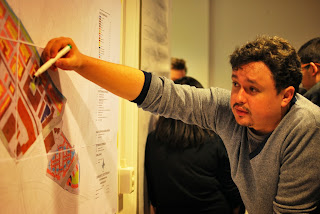 |
| Photo Credits: Alexandra Tsatsou |
Two days of work and one weekend later, today we came up
with our preliminary ideas for ZoHo. What does ZoHo need? There were many
ideas, many concepts, but the core of each idea, at least for what I felt, was
that the place needs life. In our attempts to breathe life into the place, we
presented the ideas of different activities, small endeavours to large
interventions, all focusing on the potential of what ZoHo could be…
The attempts were varied, from with-in and from with-out. Some
wanted to open the place up, bring in people from the outside, while some
wanted to bring the place to the people inside. In either case, each attempt wanted
to make sure the space turned into a living breathing place. The challenge in
this was not just rejuvenation, rather rejuvenation in a limited budget. I don’t
think I have mentioned this in my previous blogs, but the challenge in this
action plan is to make sure the first stage of intervention can be done within
a budget of 5000 Euros.
So let us see what kind of interventions we have thought of,
that can happen within this budget. Of course, it is not a long term budget, in
some of the ideas this initial budget is just to be used for establishing contacts
with stakeholders who are expected to be interested in sponsoring the actual
intervention.
As some of us think of spatial interventions to open the
place up, others think it will be a good idea to insert new activities into
this area, and some of us even think adding some activity in this place will
give it a new, improved identity. In the long run we are all trying to make
sure the place doesn’t deteriorate and is transformed into a breathing part of
a living city. So, one of the most important considerations in proposing the
idea was to understand what challenges were present on site and which of these
challenges we wanted to try to resolve.
 |
| Photo Credits: Alexandra Tsatsou |
Like, in the spatial intervention, the very fact that the
place was not visible was the challenge and the use of the potential was
proposed by making the physical space inviting by the use of interesting
facades and lighting. Similarly, the deadness of the streets and nodes was
challenged in the ground-floor revitalization program, where the interesting features
for the streets and squares would be due to the activities in the ground floors
of the surrounding buildings. Other ideas were to keep the location hidden and
turn it into a healing space for people suffering from addictions and physiological
illness, thus using the current characteristics of the space to the fullest
potential. The current characteristics of the space were also an important aspect
in the proposal for development of student hostels and accommodations, whereby
these facilities can be available in the centre of the city and at lower rents.
Some groups wanted to make sure the place became visible by creating a hype
based on events, culture, food etc. and some groups wanted to go from one small
intervention to another, working towards an organic development triggered by
familiarity and interaction within the community.
The ideas have been presented, discussed and preliminarily critiqued.
Tomorrow’s task is to develop from these starting points, the interventions
that will be Specific, Measurable, Achievable, Relevant and Time-bound, or in
abbreviation SMART. These SMART interventions shall be presented on Wednesday to
relevant stakeholders, and perhaps the ideas with feasible interventions shall
be applied. As of now, we have a big day tomorrow, and since everyone will be
busy working on the presentation for Wednesday, I hope to get some comments
from people who can spare 5-10 minutes of their time, for the blog tomorrow. The
final interventions, we will talk about them on Wednesday.
No comments:
Post a Comment